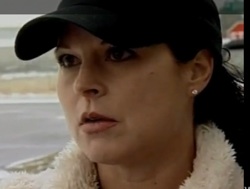Renee Cawley

The fight broke out over toys.
Renee Cawley was exercising six dogs in her Boise backyard when she ducked under an overhang to get out of the rain. She brought a handful of toys with her. The dogs followed her, but now in close quarters, they suddenly were at each others’ throats. Cawley responded instinctively – she reached down to pull them apart.
A petite woman in her 40s, Cawley had been bitten so many times during her work with aggressive dogs that she didn’t think anything of the bites she got on Dec. 3. But two days after being bitten, Cawley felt disoriented. At the time, her fiancé, David Currie, had the flu. (Sepsis and Animal Bites)
“We thought we both had the flu,” Currie said.
His mom, Loralee Gray, took Cawley to the doctor, but the blood and urine cultures showed nothing wrong. As Cawley was leaving her doctor’s office, she fainted.
She was rehydrated and told to go to the hospital if things got worse. By the time she got home, a rash had moved up her legs, marbling her skin red and white.
“It’s the scariest thing I’ve ever seen,” Currie said.
Cawley felt like her flesh was being eaten, and her temperature skyrocketed. She argued briefly with Currie about going to the emergency room because she doesn’t have health insurance. “She just figured it was an unnecessary expense,” Currie said.
Gray took Cawley to the emergency room at St. Luke’s Boise Medical Center. Cawley was screaming in pain. She doesn’t remember it, but she told them to kill her.
From the purplish, dusky, mottled color of her skin, Dr. Tom Ahlquist recognized that Cawley was septic.
“Her color was so bad,” Ahlquist said. “The problem was not that she had sepsis, but where was it from and how do we treat it.”
The dog bite was a clue, but when Currie’s mom told Ahlquist that Cawley no longer had a spleen, the doctor knew: The cause of the sepsis was capnocytophaga canimorsus, a common bacteria found in dog and cat saliva.
“The spleen normally does a pretty good job of taking care of it, but without one … they’re easily overwhelmed,” Ahlquist said.
Cawley’s spleen was removed when she was 19 as a treatment for hereditary spherocytosis, an abnormality of her blood cells. Neither her mom nor her younger sister has spleens. None of them had ever been told that a dog bite could kill them.
In the emergency room, Cawley went into cardiac arrest and her kidneys failed. Doctors induced a coma to give Cawley’s body the best shot at survival, Ahlquist said.
Cawley’s mom, Rochelle, who lives in Las Vegas, got the phone call no parent ever wants to get: Renee was dying, and Rochelle had to get to Boise immediately. “I asked God what I should do,” Rochelle said. “One of the things he told me was that I was going to see a healing, so I grabbed my camera.”
Rochelle and her husband called prayer groups before she left, asking to keep Renee alive until Rochelle could get to Boise. “We were told it was a dog bite and that she had gone septic,” Rochelle said. “I didn’t comprehend what sepsis was at the time.” There was no way for Rochelle to be prepared for what she saw when she got to St. Luke’s.
Cawley’s hands and feet were solid black as if frostbitten, as were her ears and nose. When Rochelle arrived, doctors were talking about amputating the black parts. “You always think the worst phone call you can get is that your child has died,” Rochelle said. “But what if your child has to live without her hands and feet? How is a mother to make those decisions?”
Rochelle called the prayer trees, and they prayed that Renee wouldn’t lose her limbs. Then she set about documenting what was happening to her daughter. “One of the things I was really adamant about was I was going to take pictures of where she was at and where she was going,” Rochelle said. “I just pulled back the covers and started taking pictures.”
Every couple of days, she would take pictures of the same places. Then the unexpected happened. During the three days Rene was in a coma, the color began to return to her black feet, hands and nose.
By the time doctors brought her out of the coma, just her ears and two fingers on the hand that had been bitten were black. “It’s a true miracle,” Rochelle said. “She was in total cardiac arrest. Her kidneys were gone. You don’t come back from that.”
The doctors waited several more days to see if Renee’s fingers would come back, but they didn’t. Her right index and ring finger had to be amputated. “It didn’t bother me. They had to do it for me to survive,” Renee said. “It’s amazing what I’ve learned to do already.”
Ironically, Rochelle Cawley had lost two fingers on her right hand in a lawn mower accident. “My youngest daughter was joking with Renee that you start looking like your mother when you get older,” Rochelle said. Cawley was released from the hospital only 18 days later. Then came the start of the long, arduous task of rebuilding her life.
Among the challenges she faces are short-term memory loss and night terrors. She still has open wounds that take her two hours to clean and bandage. She’s exhausted all the time and doesn’t know how she’ll pay all the medical bills.
“I’m just so thankful she’s alive with most of her body parts,” Rochelle said. “This is information that people without spleens need to know. If (Renee) knew, she never would have been training aggressive dogs.”
Since the incident, Renee said she’s met half a dozen dog owners without spleens who never knew how dangerous a bite could be. Renee’s pet services business, Reining Cats and Dogs, which she worked hard over the past two years to develop, is on hold until she recovers. The three buildings that Currie bought on Orchard Street for the business will have to be sold. But Rene gets strength from her three dogs: Trinity and Hawk, 6-year-old Australian shepherds, and Clifford, a 2-year-old Akbash dog.
On her computer, she keeps photos of Brazilian model Mariana Bridi da Costa, a 20-year-old who died in January from a sepsis infection. Doctors had amputated both of her hands and feet, and removed both kidneys trying to save her life.
“It’s difficult for me, but I shouldn’t be here,” Cawley said. “There’s a reason I survived this against all odds. My time here is not done.”


























